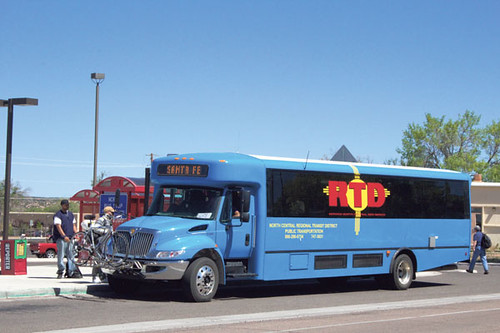BUS STORY # 310 (Airplane Bus Story)

The "Blue Bus," from the 05/09/12 Santa Fe Reporter article, “Bus-ted.” [Photo not credited.], downloaded by busboy4 on Flickr.
I’m flying to Baltimore. My seat mate is wearing jeans, a short-sleeve striped shirt, straw cowboy hat, and a watch set in a silver cuff bracelet and flanked by turquoise stones.
We get to talking about New Mexico, and about our grandchildren. He asks me what I do, and I tell him. I return the question, and he says, “I’m in public transportation.”
What are the odds?
Turns out he works for the North Central Rural Transit District up north. Their job is to stitch together the schedules of any number of small, local transit systems, including those of several of the pueblos, to make getting around the northern part of the state possible.
They also operate part of the service themselves. Locals know them as “the blue bus.”
I ask him about funding in the current economic and political environment. He acknowledges they are heavily dependent on the Feds and local government for support. Equipment procurement comes largely from securing grants which are funded anywhere from roughly 50 to 80 percent by the U.S. Department of Transportation. The administrative overhead and day-to-day operations come out of local gross receipts taxes -- not necessarily a dependably fixed amount. He understands we may be looking at an austerity budget in the near future, but he says most politicians understand the economic importance of rural public transportation, though it is difficult to measure.
A lot of that has to do with getting rural students to and from community colleges. Unemployment (with all its attendant welfare and other social services costs) is a chronic problem in this part of the state, and education has been heavily pushed as the realistic solution. (Not to mention that employment not requiring an education often involves illegal activities which, in turn, generate no tax revenue, but do cost taxpayers when law enforcement, the judicial system, and the penal system become engaged.)
We talk about ridership and gasoline prices. He says their tracking shows ridership goes up when prices go up, but when prices go back down, they retain much of the ridership. That is my sense of what happens here in Albuquerque.
We talk about alternative fuels. He believes the electric-diesel hybrids have been a real advance, and he cites continued improvement in both diesel engines and diesel itself in reducing particulate matter. He points out that hybrids only make sense for buses running longer distances between stops. That’s why we have them on our Rapid Rides, he adds.
We talk about electric, solar and hydrogen cell technology.
He is least optimistic about electric. He cites the size and weight of the batteries currently needed on our flex-bus hybrids, and says that, right now, a bus would either have to displace passenger capacity for battery capacity, or else develop routes that would accommodate frequent recharging stations. The batteries themselves are not all that long-lived, and are expensive to replace. And, he adds, it doesn’t really do all that much for the environment because the charging stations would be powered by fossil fuel-generated electricity.
I ask about solar-powered charging stations. He says solar panels -- unless there are a lot of them, and you are producing enough surplus energy to store in batteries -- are low voltage producers of electricity. Which translates into a long wait at the charging station between stops.
He thinks hydrogen has promise, but the cost-effective technology is a long way off. Right now, he says, the fuel cells used are so complex, a transportation system would have to have an engineer on site just to troubleshoot and oversee maintenance. Plus, once again, manufacturing hydrogen using fossil fuels would pretty much undercut the whole purpose of using hydrogen as a power source.
Later, I realize I failed to ask his take on compressed natural gas.
One of the most interesting discussions has to do with scheduling for paratransit systems like our own SunVan service. He explains that sophisticated scheduling software can process thousands of requests made in the previous 24 hours, converting them into a schedule of routes that will make the largest number of deliveries in the shortest amount of time using the least amount of fuel.
(We’ve recently purchased 40 new paratransit vans to replace some of the aging fleet. You can read more about that here.)
Back in Albuquerque, I will go looking for a photo of “the blue bus” for this post which will lead me to a number of articles about the NCRTD, the benefits it brings to the northern New Mexican communities, and stories from the local press, some suggesting a not-always stellar public service record at the administrative level. For those that are interested, I’ve posted the links below.
Website for the North Central Rural Transit District
“Bus-ted,” Santa Fe Reporter, 05/09/12
“The High Cost Of Free Rides,” Santa Fe Nw Mexican, 12/01/11
“Transit Boss Quits,” Albuquerque Journal, 04/26/11
“Espanola’s Blue Buses,” Horse Tail Trail, 08/10/10
__________
The photo at the top of this story is downloaded from the online 05/09/12 Santa Fe Reporter article, “Bus-ted”. The photo is not credited in the article.

0 Comments:
Post a Comment
<< Home